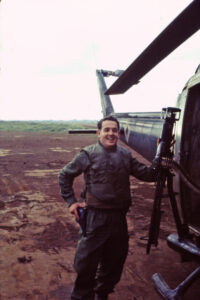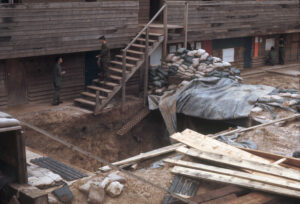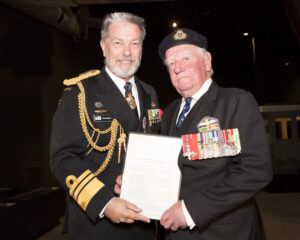Captain Robert Ray MBE RAN Retd passed away on 25 March 2023.
This obituary was compiled by his former FAA colleage, Max Speedy.
Bob joined the Navy in 1956 as an Apprentice (Aircraft Artificer) in the very first intake at HMAS NIRIMBA and in 1959 when the Government of the day announced the demise of the Fleet Air Arm, Bob was able to transfer with entitlements to Qantas, eventually becoming qualified on their Electra and other aircraft for a few years.
With the rejuvenation of the FAA in 1961/62, Bob was able at Qantas loss, to join (with no gap in service) No. 2/1962 Basic Aircrew Training Course at CERBERUS in October 1962 and while hoping for Pilot’s wings, failed, was sent to HMS FALCON (RNAS CULDROSE) in Malta, where he passed his Observer’s Course.
Fast forward to May 1968 and he is a member of Second Contingent RANHFV, where he was flown out to the rifle range on Beecroft Peninsula by Peter Ward and others in a 723 Squadron Iroquois aircraft. He and other passengers were dropped off in very strong westerly winds. Ward took off to the west in a steep climb, did a torque turn and with the wind astern flew east-ish over Bob’s head (by just a couple of feet) coastward, trying to recover from the tail wind and never being high enough at the top of the climb anyway, then hit the butts very hard and Ward and his two aircrewmen, with the aircraft on fire, went over the edge and into the sea below. Their bodies and the aircraft were recovered some days later.
In Vietnam, Bob did some hours as a gunner in the Slicks (as everyone, including non-aircrew, did in the 2nd Contingent) but was mainly involved as the sailors’ DO as well as doing some very good work (over a few months – maybe a total of 3 – 4 months all up) in Battalion and Group as their Ops Officer in the various Combat Aviation Battalions and the 12th Combat Aviation Group at the head of all helo ops in the southern half of South Vietnam. We were attached to a number of Battalions (222nd, 214th, and 145th at various times and I don’t recall the date orders but our Company’s move from Blackhorse to Bear Cat in late-Nov 1968 was one change – numbers aren’t important, the mission in this exercise didn’t change anyway! This led to his award of the MBE.

Bob Ray as a Gunner in the US Army 135th Assault Helicopter Company around November 1968, flying with Max Speedy.
Bob’s greatest chagrin was to have designed and overseen the “purchase” (a very euphemistic word in Vietnam where no one, Aussie or American alike ever purchased any item required, signatures being an anathema and a waste of good time anyway), the materials and then managed the construction of a huge bunker in the open space in front of our officers’ quarters. The bunker was definitely needed – we had one week in which 98 rockets and big mortars landed close-by. Rarely did a week go by without some “in-coming.” So that part of the plan was excellent. Said bunker was constructed and worked beautifully until it rained. Our living quarters had no gutters and every drop of the first monsoonal downpour did its worst and the bunker became a swimming pool in an hour or so and the next day collapsed.


The Bunker – before and after!
Fast forward again! Bob was the Duty Officer at Nowra on the night of the H Hangar fire. Long story short, in Mess Undress, a fire hose in hand and a team behind, he got into the hangar but with the roof about to collapse, the single hose had no chance and staying there would have imperilled his group, so they retired. (You will recall the fire hydrants had been turned off by the culprit.) Bob was awarded the Queen’s Commendation for Brave Conduct.
Around Melbourne Cup week 1976, HMAS MELBOURNE was in that fair city. A call came for the possibility of a helicopter rescue of a para-glider person who had hit the side of one of the many precipitous cliffs in the Grampians and was hanging partly by his harness and his leg jammed into a branch. So, pilot LCDR Bob Waldron (Air Force Cross – Queen’s Jubilee Honours 1977) and Bob as Observer/Navigator (Naval Board Commendation) for going down on the winch wire, extracted the injured para-glider person. Bob said he was at the full extent of the winch wire – by all accounts a well-flown and coordinated rescue.
I had the honour and great pleasure of assisting Bob in the book “A Bloody Job Well Done, the History of the RAN Helicopter Flight Vietnam 1967 – 1971,” a book which has sold about 3,000 copies.
As good friends, flying together in combat, cabin mates in Vietnam where our friendship was cemented, and for all the years that have followed, it is fair and I am proud to say Bob Ray is one of the Navy’s best role models it ever had.
VALE – Robert George Ray

Vice Admiral Tim Barrett, AO, CSC, RAN, presents Unit Citation for Gallantry certificates to members of the Royal Australian Navy Helicopter Flight Vietnam at the Australian War Memorial in Canberra.
Bob was awarded a Commendation for Brave Conduct for his actions in December 1976. The Citation reads as follows:
Lieutenant Commander Ray was attending a Wardroom function at the Naval Air Station, Nowra, on 4 December 1976, when a fire started in one of the hangars.
Lieutenant Commander Ray drove to the scene, took charge of fire fighting activities and with others manned hoses and attempted to gain entry to the hangar. However, a severe explosion occurred and despite the fact that the fire was now blazing uncontrollably he led a hose party to where the fire was fiercest. Because of the intense blaze the party was forced to withdraw from this section. Lieutenant Commander Ray then assisted in the removal of aircraft at the other end of the hangar and did so for about 2 hours. He showed commendable courage despite the ever present danger of explosion.
